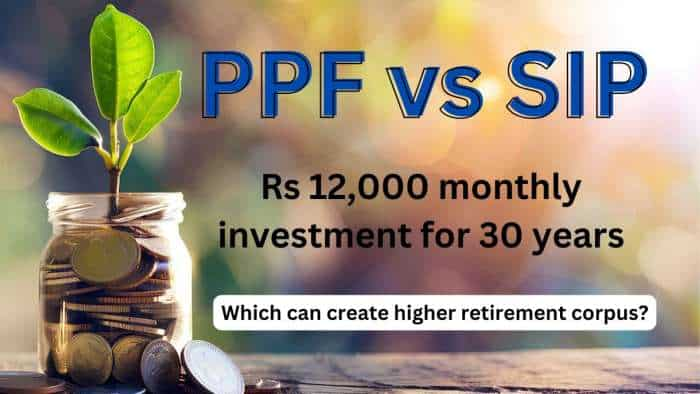PPF vs FD: Find out which is a better tax saving option
Public Provident Fund (PPF) and Fixed Deposit (FD). are both a key contenders when it comes to tax-saving and long-term investing. The ultimate pick depends on your investment goal and period.
)
Choosing the right investment avenue can sometimes be as daunting as navigating a dense forest without a map. To aid your investment journey, we've singled out two popular options – Public Provident Fund (PPF) and Fixed Deposit (FD). Both of these are key contenders when it comes to tax-saving and long-term investing. Here, we will dissect both PPF and FD to help you determine which one aligns better with your financial goals.
Understanding PPF
PPF, a government-backed long-term investment option, is much liked for its safety and attractive tax benefits. The interest rate, which is reviewed quarterly by the Finance Ministry, currently stands at 7.1 per cent per annum. A PPF account has a tenure of 15 years, extendable in blocks of five years. It operates under the Exempt-Exempt-Exempt (EEE) feature. The EEE tax status stands for Exempt-Exempt-Exempt, which makes investment exempt from taxes at the time of investment (initial contribution), during the accumulation phase (returns or interest earned), and at the time of withdrawal (maturity or redemption).
What is a fixed deposit (FD)?
Fixed Deposits are offered by banks and financial institutions, guaranteeing a fixed return over a specific period. FD interest rates vary based on the financial institution and tenure, with current rates hovering between 5.3 and 7.75 per cent per annum. Unlike PPF, FD returns are not entirely tax-free. The interest earned is taxable based on your individual tax slab.
Comparative analysis: PPF vs FD
When we pit PPF and FD against each other, various factors come into play. If we look at interest rates, PPF currently takes the lead with a rate of 7.1 per cent, slightly outperforming most FD rates.
In terms of tax benefits, PPF is a clear winner with its EEE status. However, FD also offers tax benefits under Section 80C of the Income Tax Act, allowing for deductions up to Rs. 1.5 lakh. While PPF scores high on long-term wealth accumulation, FD brings flexibility and liquidity to the table, catering to short-term needs. This is because PPF has a minimum investment duration of 15 years while FDs offer far more flexible options.
Choosing between PPF and FD hinges upon your personal needs and financial objectives. If you are aiming for tax-free returns and long-term wealth creation, PPF could be your best bet. However, if you are eyeing flexibility and liquidity with a guaranteed return, then FD might be more up your alley. A judicious mix of both might also serve to diversify and balance your investment portfolio. It is advisable to consult a financial planner to make an informed decision.
Get Latest Business News, Stock Market Updates and Videos; Check your tax outgo through Income Tax Calculator and save money through our Personal Finance coverage. Check Business Breaking News Live on Zee Business Twitter and Facebook. Subscribe on YouTube.
RECOMMENDED STORIES

PPF vs SIP: Rs 12,000 monthly investment for 30 years; see which can create higher retirement corpus

Largecap, Midcap Stocks To Buy: Analysts recommend buying L&T, Tata Motors, 3 other stocks for 2 weeks; check targets

Power of Rs 15,000 SIP: How long it will take to achieve Rs 7 crore corpus? See calculations to know
02:06 PM IST











 PPF vs SIP: Rs 12,000 monthly investment for 30 years; see which can create higher retirement corpus
PPF vs SIP: Rs 12,000 monthly investment for 30 years; see which can create higher retirement corpus PPF vs Sukanya Samriddhi Scheme: Which can create a larger corpus on maturity with Rs 1.5 lakh annual investment for 15 years?
PPF vs Sukanya Samriddhi Scheme: Which can create a larger corpus on maturity with Rs 1.5 lakh annual investment for 15 years? Investment Strategy: How you can earn interest in this guaranteed return scheme without investing a single rupee after 15-year lock-in period
Investment Strategy: How you can earn interest in this guaranteed return scheme without investing a single rupee after 15-year lock-in period Sukanya Samriddhi, Kisan Vikas Patra, 15-year PPF, National Savings Certificate, other small savings schemes to pay these returns in Q3 FY25
Sukanya Samriddhi, Kisan Vikas Patra, 15-year PPF, National Savings Certificate, other small savings schemes to pay these returns in Q3 FY25 SSY, PPF, NSS: These small savings schemes to have new rules from October 1; will it benefit you? Check details
SSY, PPF, NSS: These small savings schemes to have new rules from October 1; will it benefit you? Check details